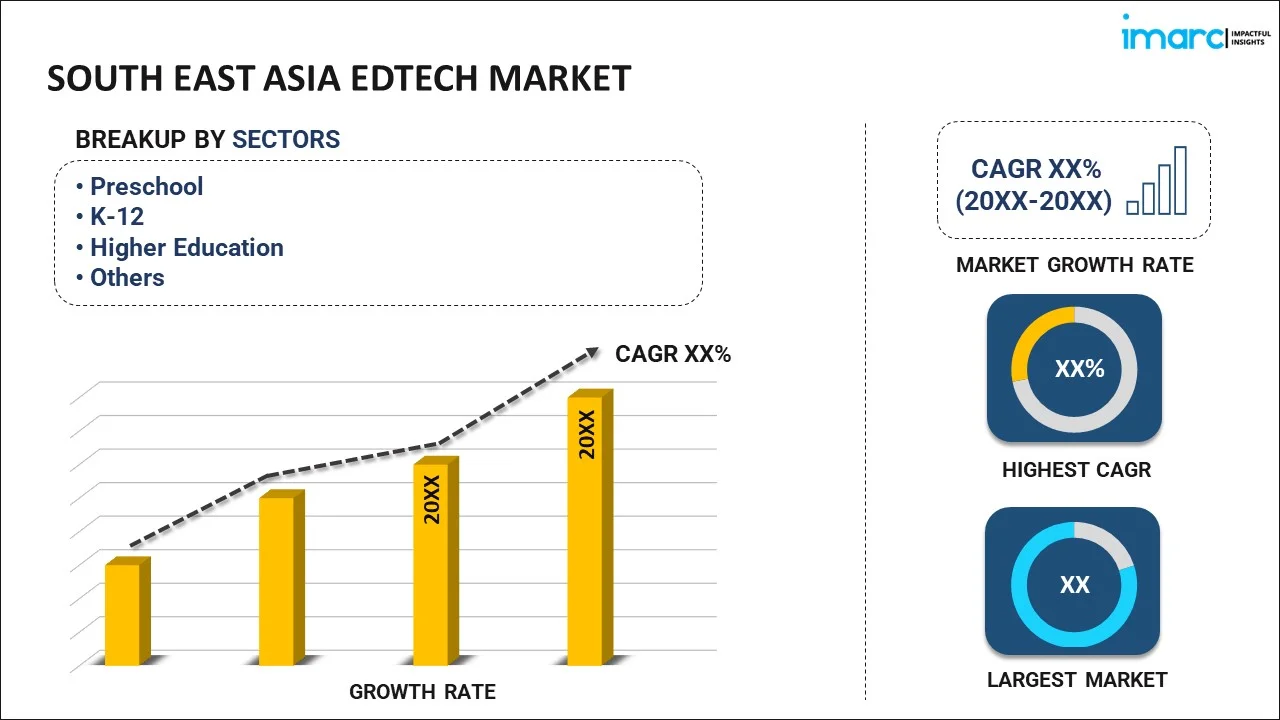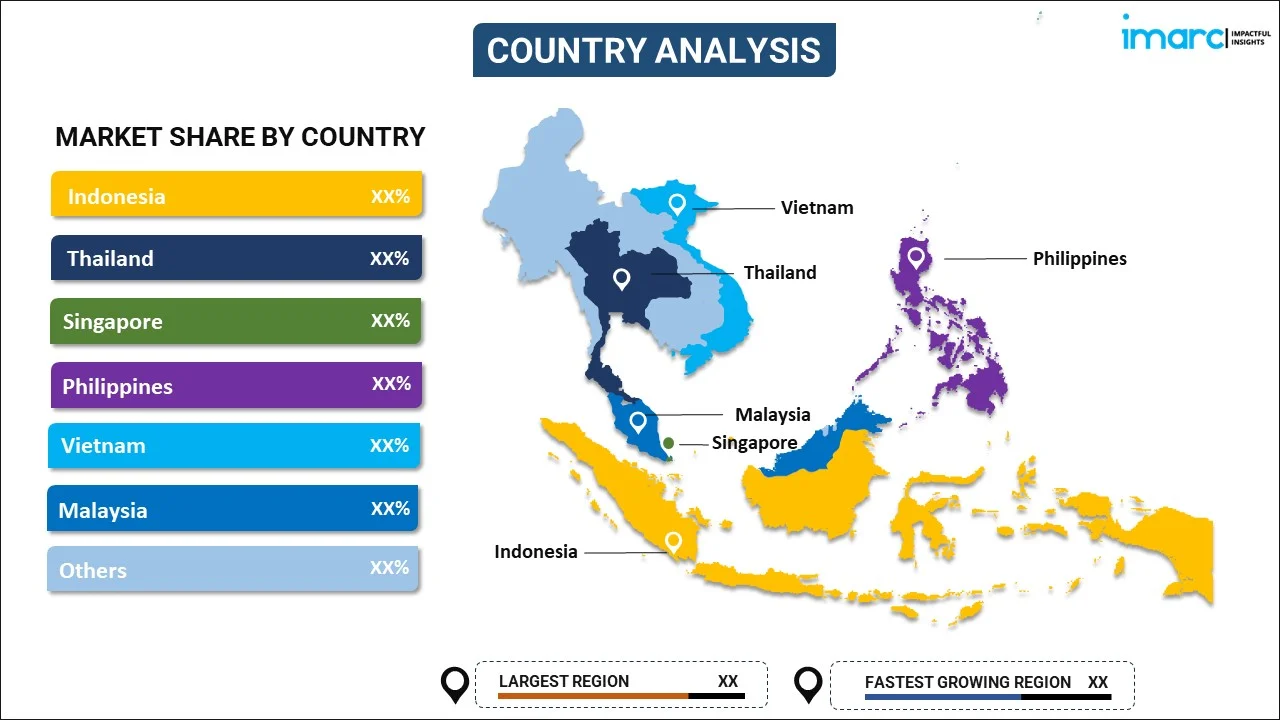
South East Asia Edtech Market Report by Sector (Preschool, K-12, Higher Education, and Others), Type (Hardware, Software, Content), Deployment Mode (Cloud-based, On-premises), End User (Individual Learners, Institutes, Enterprises), and Country 2025-2033
Market Overview:
South East Asia Edtech market size reached USD 10.7 Billion in 2024. Looking forward, IMARC Group expects the market to reach USD 41.5 Billion by 2033, exhibiting a growth rate (CAGR) of 14.7% during 2025-2033. The integration of data analytics and learning analytics, which allow educators to track and analyze student performance, is driving the market.
|
Report Attribute
|
Key Statistics
|
|---|---|
|
Base Year
|
2024
|
|
Forecast Years
|
2025-2033
|
|
Historical Years
|
2019-2024
|
|
Market Size in 2024
|
USD 10.7 Billion |
|
Market Forecast in 2033
|
USD 41.5 Billion |
| Market Growth Rate 2025-2033 | 14.7% |
Edtech, short for educational technology, refers to the integration of technology into educational practices to enhance learning experiences. It encompasses a broad range of tools, software, and resources designed to facilitate and support education at various levels. Edtech aims to revolutionize traditional teaching methods by incorporating digital solutions, interactive platforms, and online resources. This includes virtual classrooms, e-learning modules, educational apps, and collaborative tools that cater to diverse learning styles. Edtech not only democratizes access to education but also promotes personalized learning, allowing students to progress at their own pace. Teachers benefit from streamlined administrative tasks, data-driven insights, and the ability to tailor lessons to individual student needs. As technology continues to advance, Edtech plays a pivotal role in shaping the future of education, fostering innovation, and preparing students for the challenges of the digital age.
South East Asia Edtech Market Trends:
The Edtech market in South East Asia is thriving, propelled by several key drivers that have transformed the educational landscape. Firstly, the regional digitization wave has catalyzed the adoption of technology across sectors, prompting educational institutions to integrate digital tools into their teaching methodologies. As a result, Edtech has become a pivotal enabler, enhancing accessibility and scalability in education. Additionally, the increasing demand for personalized and adaptive learning experiences has contributed significantly to the growth of Edtech. Technological advancements such as artificial intelligence and machine learning enable the development of tailored learning modules catering to individual needs and learning styles. This customization not only enhances student engagement but also optimizes the learning outcomes. In conclusion, the Edtech market in South East Asia is driven by a confluence of factors, including digitalization trends and the demand for personalized learning. These interconnected drivers continue to shape the dynamic landscape of education, fostering innovation and accessibility on a larger scale.
South East Asia Edtech Market Segmentation:
IMARC Group provides an analysis of the key trends in each segment of the market, along with forecasts at the regional and country levels for 2025-2033. Our report has categorized the market based on sector, type, deployment mode, and end user.
Sector Insights:

- Preschool
- K-12
- Higher Education
- Others
The report has provided a detailed breakup and analysis of the market based on the sector. this includes preschool, k-12, higher education, and others.
Type Insights:
- Hardware
- Software
- Content
A detailed breakup and analysis of the market based on the type have also been provided in the report. This includes hardware, software, and content.
Deployment Mode Insights:
- Cloud-based
- On-premises
The report has provided a detailed breakup and analysis of the market based on the deployment mode. This includes cloud-based and on-premises.
End User Insights:
- Individual Learners
- Institutes
- Enterprises
A detailed breakup and analysis of the market based on the end user have also been provided in the report. This includes individual learners, institutes, and enterprises.
Country Insights:

- Indonesia
- Thailand
- Singapore
- Philippines
- Vietnam
- Malaysia
- Others
The report has also provided a comprehensive analysis of all the major regional markets, which include Indonesia, Thailand, Singapore, Philippines, Vietnam, Malaysia, and Others.
Competitive Landscape:
The market research report has also provided a comprehensive analysis of the competitive landscape in the market. Competitive analysis such as market structure, key player positioning, top winning strategies, competitive dashboard, and company evaluation quadrant has been covered in the report. Also, detailed profiles of all major companies have been provided.
South East Asia Edtech Market Report Coverage:
| Report Features | Details |
|---|---|
| Base Year of the Analysis | 2024 |
| Historical Period | 2019-2024 |
| Forecast Period | 2025-2033 |
| Units | Billion USD |
| Scope of the Report | Exploration of Historical and Forecast Trends, Industry Catalysts and Challenges, Segment-Wise Historical and Predictive Market Assessment:
|
| Sectors Covered | Preschool, K-12, Higher Education, Others |
| Types Covered | Hardware, Software, Content |
| Deployment Modes Covered | Cloud-based, On-premises |
| End Users Covered | Individual Learners, Institutes, Enterprises |
| Countries Covered | Indonesia, Thailand, Singapore, Philippines, Vietnam, Malaysia, Others |
| Customization Scope | 10% Free Customization |
| Post-Sale Analyst Support | 10-12 Weeks |
| Delivery Format | PDF and Excel through Email (We can also provide the editable version of the report in PPT/Word format on special request) |
Key Questions Answered in This Report:
- How has the South East Asia edtech market performed so far and how will it perform in the coming years?
- What has been the impact of COVID-19 on the South East Asia edtech market?
- What is the breakup of the South East Asia edtech market on the basis of sector?
- What is the breakup of the South East Asia edtech market on the basis of type?
- What is the breakup of the South East Asia edtech market on the basis of deployment mode?
- What is the breakup of the South East Asia edtech market on the basis of end user?
- What are the various stages in the value chain of the South East Asia edtech market?
- What are the key driving factors and challenges in the South East Asia edtech?
- What is the structure of the South East Asia edtech market and who are the key players?
- What is the degree of competition in the South East Asia edtech market?
Key Benefits for Stakeholders:
- IMARC’s industry report offers a comprehensive quantitative analysis of various market segments, historical and current market trends, market forecasts, and dynamics of the South East Asia edtech market from 2019-2033.
- The research report provides the latest information on the market drivers, challenges, and opportunities in the South East Asia edtech market.
- Porter's five forces analysis assist stakeholders in assessing the impact of new entrants, competitive rivalry, supplier power, buyer power, and the threat of substitution. It helps stakeholders to analyze the level of competition within the South East Asia edtech industry and its attractiveness.
- Competitive landscape allows stakeholders to understand their competitive environment and provides an insight into the current positions of key players in the market.
Need more help?
- Speak to our experienced analysts for insights on the current market scenarios.
- Include additional segments and countries to customize the report as per your requirement.
- Gain an unparalleled competitive advantage in your domain by understanding how to utilize the report and positively impacting your operations and revenue.
- For further assistance, please connect with our analysts.
 Inquire Before Buying
Inquire Before Buying
 Speak to an Analyst
Speak to an Analyst
 Request Brochure
Request Brochure
 Request Customization
Request Customization




.webp)




.webp)












